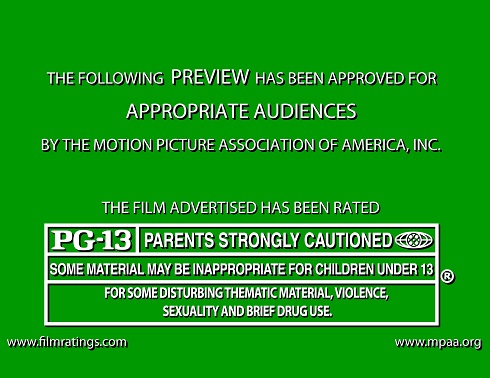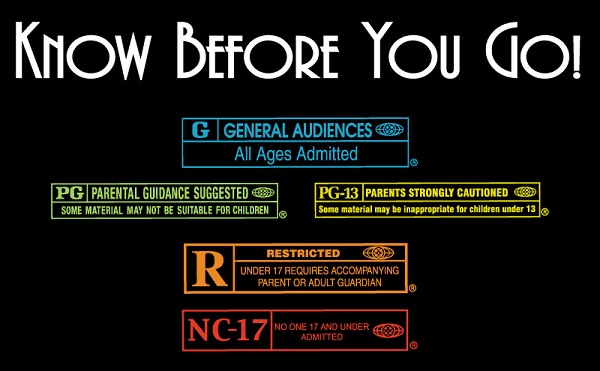Movie Review with Jeff McCullough: The Problem with Film Ratings
By Jeff McCullough on February 07, 2015 from Movie Review via Connect-Bridgeport.com
 Film is an industry unlike no other, run by the creativity and genius of artists, to make the best, and by consequence most profitable, product possible. However, there’s been an ugly blight hampering the creative flow and hamstringing directors for a while now. This unfortunate blemish is the MPAA, or Motion Picture Association of America, a somewhat mysterious board designed to rate films for their adult content, in an often heedless attempt to prevent parents from accidently scarring their wee ones with pictures of Jason Voorhees braining someone or even (gasp) a naked body. However, what was initially a good hearted effort quickly turned to one of the most ill thought and ridiculous processes ever conceived in an industry already known for its ridiculousness.
Film is an industry unlike no other, run by the creativity and genius of artists, to make the best, and by consequence most profitable, product possible. However, there’s been an ugly blight hampering the creative flow and hamstringing directors for a while now. This unfortunate blemish is the MPAA, or Motion Picture Association of America, a somewhat mysterious board designed to rate films for their adult content, in an often heedless attempt to prevent parents from accidently scarring their wee ones with pictures of Jason Voorhees braining someone or even (gasp) a naked body. However, what was initially a good hearted effort quickly turned to one of the most ill thought and ridiculous processes ever conceived in an industry already known for its ridiculousness.
There are five ratings given out by the MPAA, but only two that restrict the viewers. R-rated films are supposed to prevent kids under the age of 17 from entering a film without a parent. In reality, most just buy a ticket for the latest Disney flick before sneaking into Rise of the Zombie Janitors from Hell, or whatever 13-year-olds are into these days. NC-17 isn’t allowed to be shown to them at all, and most theaters won’t show films above an R rating due to the extremely graphic nature of most films in this category.
In general, this means an R-rated film will likely gross less money than if it’d received a lighter PG-13 rating, due to one of the largest groups still buying movie tickets, teenagers, being cut off, while the NC-17 is a financial death touch, limited to a film festivals and a couple shady theaters with a broken window and popcorn that smells as bad as the pizza-faced employee who hands it to you. Like any industry, films need to make money, and R-rated and NC-17 simply don’t make it, at least not in the amounts most studios want. This leads to cut happy producers hacking the film to shreds, leading to an often unsatisfying and disjointed mess, one that more people might see, but a far cry from the quality of the original.
 Many different movies face the MPAA’s chopping block, but no genre feels the hurt more than horror. By its nature, horror, next to maybe Last Tango in Paris style erotic thrillers, contain the content most prone to getting slapped with an R-rating, or even the dreaded NC-17. 2006’s The Hills Have Eyes was a fantastic film that was more or less unwatchable in theaters. Two minutes of the more gory scenes were cut to secure an R-rating, which might not seem like lot, but for a horror film whose scares rely heavily on cannibalistic, axe wielding mutants, those two minutes meant the difference between an edgy, knuckle biting film of almost unbearable tension and something as tame as your average Teletubbies episode. Thankfully for the unrated DVD cut, Hills was back to all its sickening glory, but the fact it had to be cut at all was just a slap in the face to fans and a hindrance for the director.
Many different movies face the MPAA’s chopping block, but no genre feels the hurt more than horror. By its nature, horror, next to maybe Last Tango in Paris style erotic thrillers, contain the content most prone to getting slapped with an R-rating, or even the dreaded NC-17. 2006’s The Hills Have Eyes was a fantastic film that was more or less unwatchable in theaters. Two minutes of the more gory scenes were cut to secure an R-rating, which might not seem like lot, but for a horror film whose scares rely heavily on cannibalistic, axe wielding mutants, those two minutes meant the difference between an edgy, knuckle biting film of almost unbearable tension and something as tame as your average Teletubbies episode. Thankfully for the unrated DVD cut, Hills was back to all its sickening glory, but the fact it had to be cut at all was just a slap in the face to fans and a hindrance for the director.
Ratings are handed out vending machine style. A movie goes in and a little sheet of paper comes out containing the film’s rating. What isn’t handed out is anything beyond a very basic description of why the film received its rating, leading to a dilemma for the filmmakers. Do they delete that gory car accident? Or maybe censor that unfortunate shot of Jenifer Lopez in a revealing set of undergarments? Or both? All the director can do is keep on cutting and shredding their film to shreds and sending in new versions, hoping one of them can get by with an R or PG-13. If the MPAA would point to specific scenes and content that might have garnered the rating, than this would be a non-issue, but they stubbornly refuse, adding more fuel to the already heated fire.
And finally one last problem, perhaps the largest, is still sticking out like rotten skin on a bad peach. This archaic rating system keeps films that need to be seen by teens away from them. One famous and controversial case was the rating of the film Bully. A 2011 documentary, Bully followed the heart breaking story of victims of school based harassment and the effects it had on children’s lives. Rated R for “some language” (in reality a few uses of the F-word, a term only the most hopelessly innocent of 13 year olds aren’t already well acquainted with) Bully was largely unseen by those who needed it most, the teenagers. Sure, its great adult audiences will see it, but it’s the kids that see, are subjected to, and sometimes participate, in this violence on a daily basis. They’re the ones this film could’ve made a difference for.
On the other side of the coin, The Expendables 3, a film with a pg-13 rating, over 500 onscreen deaths, primarily supplied by the machine gun fire of Sylvester Stallone and his merry band of roided up senior citizens. This doesn’t mean The Expendables 3 deserves an R rating, but it does bring a question. Does hearing the F-word a few times produce a more negative effect on children than seeing literally hundreds of men gunned down? According to current MPAA standards, and against common sense, it does, and this contrast between language and violence shows an inner inconsistency in an already deeply flawed system.
Clearly the problems with the MPAA are numerous and lengthy, but these holes can be patched before the ship completely capsizes. The rating systems should be a warning to parents, not a means of censorship. If little Susie’s mom lets her go see Texas Chainsaw Massacre 5, then let that be on her head. This is one task parents should be responsible for, not yet another government agency.

